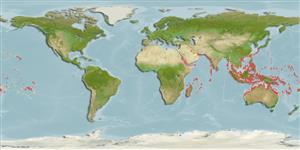Common names from other countries
Classification / Names / Names
आम नाम | उपशब्द | Catalog of Fishes (gen., sp.) | ITIS | CoL | WoRMS
Environment: milieu / climate zone / depth range / distribution range
पारिस्थितिकी
; खारा; गहराई सीमा 0 - 20 m (Ref. 348). Tropical; 31°N - 33°S, 30°E - 137°W
Indo-Pacific: from East Africa, including Madagascar, the Red Sea, Persian Gulf and Andaman Sea, to eastern Polynesia; north to Japan and south to central Queensland and New Caledonia.
Length at first maturity / आकार / वज़न / Age
Maturity: Lm 2.5 range ? - ? cm Max length : 11.0 cm SHL पुल्लिंग / अलिंग; (Ref. 348); common length : 6.5 cm SHL पुल्लिंग / अलिंग; (Ref. 348)
Average edible weight is at 9 g (Ref. 351). Maximum depth from Ref. 75831. Littoral and sublittoral to a depth of about 20 m (Ref. 345). Found in intertidal areas in sand (Ref 75831). Deeply buried in sand, often coarse to gravel bottoms (Refs. 345, 126564). In general, suspension feeding bivalves mainly depend on phytoplankton and detritus material for nutrition (Ref. 107088).
Life cycle and mating behavior
परिपक्व अवधि | पुनरुत्पत्ति | मछलीऔ का अंडे देना | अंडे | Fecundity | लार्वा
Mass spawning occurs in late summer and larval stage is about 14 days (Ref. 351).
Poutiers, J.M. 1998. (Ref. 348)
IUCN Red List Status (Ref. 130435)
CITES status (Ref. 108899)
Not Evaluated
Not Evaluated
Threat to humans
Harmless
Human uses
मात्स्यिकी: व्यापारिक
| FishSource | Sea Around Us
साधन
अधिक जानकारी
Age/Sizeबाढ़Length-weightLength-lengthआकृति विज्ञानलार्वाबहुतायत
इंटरनेट स्रोत
Estimates based on models
Preferred temperature
(Ref.
115969): 25 - 29.3, mean 28.4 (based on 3504 cells).
Vulnerability
Low vulnerability (10 of 100).
Price category
Unknown.
